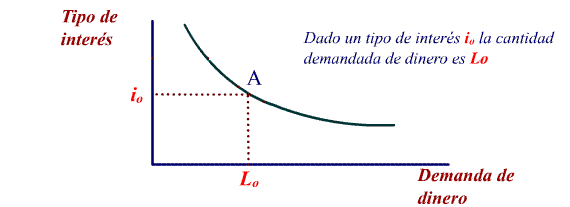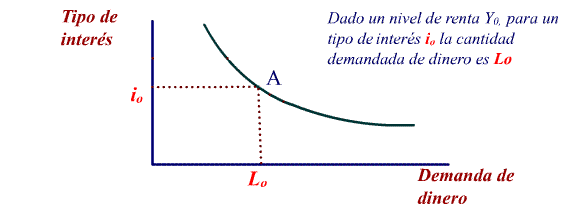DEMAND FOR MONEY
People want to have a part of their money in
cash (demand for money) for different motives, amonst others we
can point out:
To be able to carry out transaction
- to be able to pay for things they buy.
The quantity demanded for this
motive depends mainly on a person's level of income: the greater
the income the greater the consumption and therefore the greater
the demand for money (and if income is less then the opposite
occurs).
Demand as financial asset: money
has a value and the public may prefer to maintain a part of
their richness in the form of liquid money, especially during
moments of uncertaintly.
Instead of having money in a bank
that can go bankrupt or in shares that can sink. During moments
of crisis people prefer to have money at home.
The demand for money, for one or another reason,
presents a negative relationship with the interest rate:
If interest rates increase, the
cost of opportunity to have liquid money increases as people
prefer not to have it deposited in a bank where it gains interest.
Therefore, people will try and have the necessary minimum in
liquid.
If on the contary interest rates
decrease the cost of opportunity reduces, which will make people
not care about maintaining a large proportion of their savings
in cash.
This reverse relationship between interest rate
and demand for money can be represented in a graph.

A = Given an interest rate io defendant the amount of money is Lo
B = If the interest rate increases the quantity demanded i1 decreases L1 money (the opportunity cost is higher)
C = if the interest rate decreases the quantity demanded i2 money increases to L2 (the opportunity cost is lower)
Variations
in the interest rates provoke movements along the curve:
If income increases, consumption
will increase, which will means people will keep more money
in cash to be able to pay for purchases: the demand for money
curve will move to the right (for the same interest rate people
will demand more money).
If income decreases, consumption
will decrease and therefore, the need people have to maintain
money in cash: the demand for money curve will move towards
the left.

A = Given a level of income Yo, for an interest rate of io the quantity demanded money Lo
B = If your income level rises to Y1 the amount of money is demanded for the same interest rate is now greater I0 (L1)
C = Y if the income level drops to Y2, the amount of money is demanded for the same interest rate is lower io (L2)
Well then, this lesson
has been more simple than the previous, so no one can complain.

